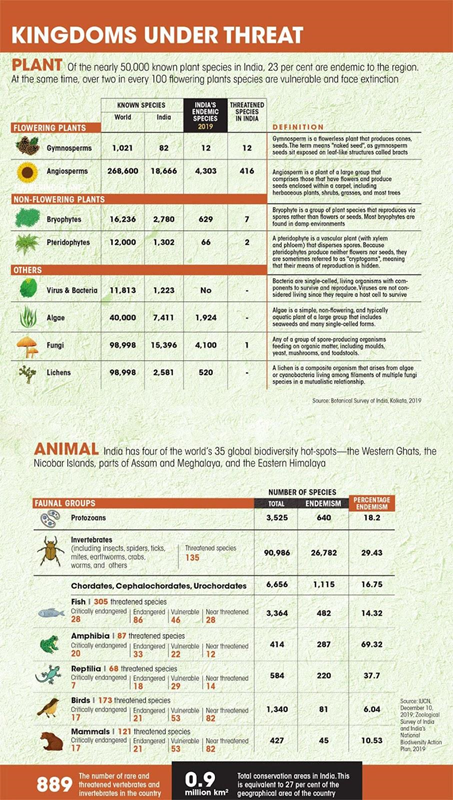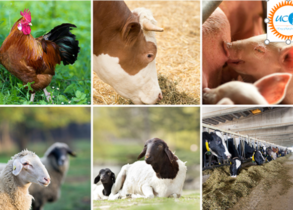Foreseeing Sixth Mass Extinction
Why in the News?
- Recently a new study led by the University of Hawaii claimed that Earth is witnessing its sixth mass extinction event.
What is Mass Extinction?
- A mass extinction is when a significant portion of biodiversity, or distinct species—bacteria, fungi, plants, mammals, birds, reptiles, amphibians, fish, and invertebrates—die off over a brief period of geological time.
- It’s significant to highlight in this definition that a “short” period in geological time might last for thousands or even millions of years.
- The last mass extinction event on the world, which exterminated the dinosaurs 65,5 million years ago, was one of five that have previously occurred on the planet.
- According to experts, we are currently experiencing the sixth mass extinction.
More about the extinction predictions
- A mass extinction:
- Studies show that loss of species is taking place across all ecosystems — from land to oceans, from the sea surface to the yet-to-be-fully-explored seafloors, from forests to desert, and from swamps to rivers.
- This proves that a mass extinction event is taking place.
- The Living Planet Report by WWF:
- The Living Planet Report by World Wide Fund for Nature released in October this year said there has been a 69 per cent decline in the wildlife populations of mammals, birds, amphibians, reptiles and fish, across the globe in the last 50 years.
- Marine species:
- Scientists have also warned of an imminent mass annihilation of marine species similar to one 250 million years ago that wiped out most lives in oceans.
- Migratory fish species:
- Habitat loss and barriers to migration routes were responsible for about half of the threats to monitored migratory fish species.
- Human induced:
- Humans have annihilated 83 per cent of all wild mammals and half of all plants, according to a census of the biomass on Earth.
Consequences
- Interdependent ecology:
- The landmass is negatively impacted by the rising pace of species loss.
- Every living thing on Earth is a component of the intricate ecosystem, and each one is rational and has a purpose.
- Every single one of them provides an ecosystem function to the other that has developed alongside them over billions of years as they carved out their own social or ecological niches. When one falls short, the other stumbles.
- Moving towards poles:
- According to the IPCC study, half of all species are relocating to higher elevations or the poles in order to adjust to the planet’s changing environment.
- At sea, animals have migrated poleward at an average rate of 59 kilometres per decade as a result of global warming.
- Missing SDG targets:
- The world may miss the UN Sustainable Development Goals (SDG) targets by a wide margin if human civilisation does not pull up its socks and promptly acts to protect the natural order.
Causes
- The “Living Planet Report 2020” points out five major reasons behind the biodiversity loss across the planet:
- Changes in land and sea use (habitat loss and degradation),
- Overexploitation of species,
- Invasive species and disease,
- Pollution and
- Climate change.
- Pollution & Climate Change:
- Habitat degradation, species overexploitation, invasive species, and disease are the key contributors to species extinction in the Asia-Pacific region, including India, where it is higher than the global average. Pollution and climate change made a bigger proportional contribution, at 16%.
- Invasive alien species:
- Invasive alien species have spread across and populated faster.
- They have been regarded as the most serious drivers of biodiversity loss across the Asia-Pacific region.
- Overexploitation of species:
- In just the last three centuries, global forest areas have shrunk by 40 per cent.
- Every year, to meet the timber needs from natural sources, the Earth is stripped of 100 million trees.
- They store 50 per cent of the world’s terrestrial carbon and provide a buffer from extreme weather, such as hurricanes and tsunamis.
- Human induced:
- The current rate and scale of extinction is unprecedented and is being caused majorly by humans.
- The rate and scope of extinction at our time are unprecedented, and people are mostly to blame.
- Human activity has actively eliminated certain species from the earth and put many more in danger, from greenhouse gas emissions and ozone depletion to deforestation, plastic waste accumulation, and the illegal animal trafficking.
- Organisms may find the current era of warming caused by humans to be an unsuitable circumstance.
- Change in ocean circulation pattern and climate cooling:
- Cooling climate likely changed the ocean circulation pattern. This caused a disruption in the flow of oxygen-rich water from the shallow seas to deeper oceans, leading to a mass extinction of marine creatures.
Suggestions & Way ahead
- Treating them as one:
- Biodiversity loss and climate crisis should be dealt with as one instead of two different issues as they are intertwined.
- Regulating wildlife markets:
- Following the current pandemic, wildlife markets have come under scrutiny as being not only environmentally irresponsible but also possibly harmful to human health due of zoonotic diseases like COVID-19 that spread from animals to humans.
- These markets, which deal in live exotic animals or goods made from them, are present all over the world.
- Monitoring species population:
- Monitoring species’ populations and seeing issues before it’s too late to help is one of the best methods to help save them from going extinct.
- Currently, the primary technique of data collecting uses video traps and surveys carried out on foot or from an aeroplane.
- Institutional efforts:
- Legislation will always be at the vanguard of the fight against mass extinction, from fighting global pollution emissions in the 2016 Paris Agreement to the U.K.’s Global Resource Initiative that combats deforestation.
- 30X30:
- Our leaders can support the America the Beautiful initiative to conserve 30% of US lands and waters by 2030.
- UN Biodiversity Summit:
- US leadership can play a critical role beside 195 other countries and agree to new ambitious global goals on biodiversity and how they can be financed and implemented.





